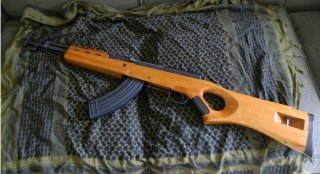The Russian SKS Rifle is An Unsung Staple of the Cold War
History hasn't awarded this rifle nearly as large a place as it deserves.
Here's What You Need To Remember: Taken all together, the SKS was a great improvement over its predecessors, most especially the aged Mosin-Nagant bolt-action rifle. The SKS was lighter, had double the magazine capacity, and was semi-automatic. Unfortunately for the rifle, the AK-47 was just too good to pass up. Still, the SKS makes for an interesting piece of World War Two and Cold War history.
The SKS was the first rifle to replace the Soviet Union’s bolt-action Mosin-Nagant of Imperial Russian vintage. It was about time too—the Mosin-Nagant had served the Tsar’s troops since 1891. It was overpowered and had a small five-round magazine, limiting a soldier's firepower. Recoil was excessive as was the Mosin-Nagant’s weight.
SKS production began in 1945 and was an improvement of the AVS-36 rifle, one of the world’s first selective fire rifles. Though the AVS had a higher magazine capacity than the Mosin-Nagant, it used the same overly-powerful 7.62x54mmR cartridge. Using the more moderately powerful 7.62×39mm round, Soviet gunsmiths went to work designing something more reliable and better suited to the shorter range battles of World War Two.
SKS
The 7.62×39mm was a much more manageable round thanks to its much lower recoil. The SKS also had a 10-round non-detachable magazine that was loaded via a stripper clip. Compared to the Mosin-Nagant, the SKS had double the magazine capacity. The SKS also had a foldable bayonet mated to the underside of the barrel that could swing 180 degrees outward and clip into place. Though the bayonet could be rapidly deployed, it was rather cumbersome and added to the rifle’s weight.
Overall, the SKS was an improvement over the Mosin-Nagant. It was prized for its ease of manufacture, ruggedness, and pain-free maintenance. Despite the overall positive characteristics, the SKS had a very short life as a service rifle with the Soviet Union. The advent of the iconic and superior AK-47 ended the SKS’ frontline service, though the rifle continued to be manufactured in the Soviet Union for use with their satellites and allies and abroad, mostly by other communist states.
China manufactured the SKS in massive numbers for both People’s Liberation Army soldiers, and for their Communist allies in north Vietnam where the rifle served both as a front-line weapon and as a civilian issue rifle for village protection.
Today, the SKS has a following on the civilian market, where it is used as a plinker, and as a hunting rifle. Despite the 7.62×39mm cartridge’s more modest characteristics, it is sufficient for taking down small and medium-sized game animals. The rifle’s ubiquitousness and relatively low cost make it an easily accessible platform for most shooters, despite the lack of a mount for modern scopes.
Relegated to History
Taken all together, the SKS was a great improvement over its predecessors, most especially the aged Mosin-Nagant bolt-action rifle. The SKS was lighter, had double the magazine capacity, and was semi-automatic. Unfortunately for the rifle, the AK-47 was just too good to pass up. Still, the SKS makes for an interesting piece of World War Two and Cold War history.
Caleb Larson is a defense writer with the National Interest. He holds a Master of Public Policy and covers U.S. and Russian security, European defense issues, and German politics and culture. This article first appeared last year.
Image: Flickr

